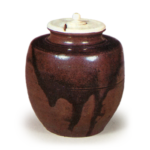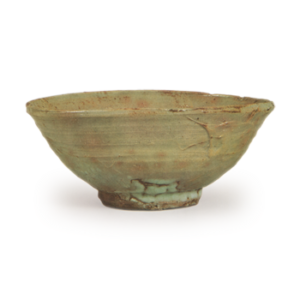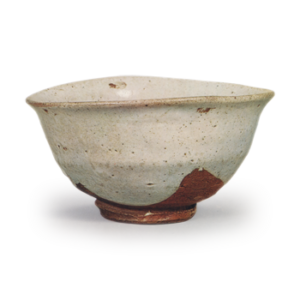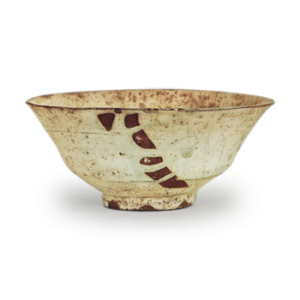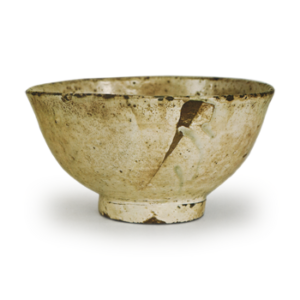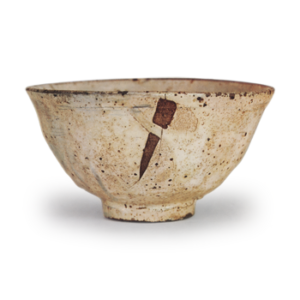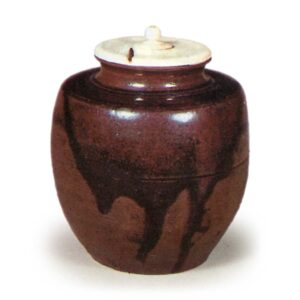
A great masterpiece. A tea caddy with a shoulder impulse, by Han. According to Shinshosai Shunkei’s “Classification of Plants and People”, “Hatsuhana” means “first flower” in Japanese, and “Hatsuhana” means “first flower” in Japanese because the pot opens earlier than in the rice paddies. The Taisho Meikikan (The History of Japanese Ceramics) says, “The shape and color of the glaze are elegant and beautiful, and it is said that it is like the first fragrant flower to bloom in the springtime under heaven. This tea caddy is said to have been the king of the shoulder-imposing tea caddy since ancient times, and its overall shape is described as perfect and flawless with the utmost elegance. The three black glazed draperies on the side of the bowl have different lengths, each with a different hanging state, and each starts with a grainy black blot from a mixture of light persimmon and light purple on the ground, gradually becoming darker, and the line leading to the glaze stop is gently curved and traces across the bowl.
The base is purple and has the soft taste of strained clay. The bottom of the bowl has a very fine thread cutting. The single strap on the body is in a very good position. In all respects, this is a perfect piece, but if I had to single out a flaw, it would be that it is too graceful and feminine, lacking in solemnity. Arai Shiraishi, in his “Shinsho” (A Book of Gentlemen), describes this tea caddy as “the oil pot of Yang Kwei-hui,” which is a false theory, but there must have been a legend like this at that time. It was first owned by Ashikaga Yoshimasa, and later passed through Torii Hikiutoshi in Nara to Hikita Eiho, a Daimonjiya in Kyoto. According to the “Nobunaga Koki”, it was given to Oda Nobunaga by Daimonjiya when he entered Kyoto on February 27, 1569, and it is known that Nobunaga held tea ceremonies using this tea container in 1574, 1577, and 1578. The tea ceremony was held in 1578 (Doyo 6) using this tea container. The “Nobunaga no Koki” (The Lord Nobunaga’s Diary) states that on October 28, 1577, Nobunaga’s son, Nobutada, displayed a number of famous tea utensils, including Hatsuhana, at Azuchi Castle and showed them off to the lords and princes. According to the “Taikoki,” Nobunaga gave the Hatsuhana shoulder implements to Nobutada at Azuchi Castle in December 1578, along with other famous tools. However, on June 2, 1582, the Honnoji Incident occurred, and Mitsuhide Akechi came to Azuchi Castle, took the treasures of the Tenshukaku and returned to Kyoto, but was soon killed in Yamazaki, and on June 14, Mitsuharu Akechi set fire to Azuchi Castle. It is not known whether Mitsuhide took the Hatsuhana Kashira from Azuchi Castle during this great upheaval, or whether it was taken away by some people when Azuchi Castle was set on fire by the military. In April 1583, he presented this tea caddy to Tokugawa Ieyasu in Hamamatsu. Later, when Hideyoshi defeated Katsuie Shibata, and the situation in Japan returned to Hideyoshi’s favor, Ieyasu sent this first flower to Hideyoshi on May 21, 1583, with Kazumasa Ishikawa as his envoy, to celebrate his victory in the war. This is clearly stated in “Kanseijyushushoku Shujikefu” and “Butoku Hennenshusei”. Therefore, the first flower was in Ieyasu’s possession for only one month. Hideyoshi was very happy to have it and used it for tea ceremonies. In particular, Hideyoshi displayed it at a tea ceremony held in the Forbidden City on October 7, 1585, and at the Kitano Grand Tea Ceremony on October 1, 1587, as well as at the Nagoyasanri tea ceremony held on November 6, 1592. In the “Meimonokiki,” there is a reference to “Taikoh Hideyoshi’s relics in the possession of Bizen Chunagon Hideie,” which suggests that it was given to Ukita Hideie as a relic after Taikoh’s death.
Hideie was an adopted son of Taikoh, and was successful in several battles, but fled to Satsuma (Kagoshima Prefecture) after joining forces with Mitsunari Ishida and being defeated in the Battle of Sekigahara. It is written in “Tokugawa Gozeiki” and “Han Hanboku” that his retainer Shindo Masatsugu saved Hideie’s life by showing him Torikai Kunitsugu’s sword and defending him as proof of his death in battle, and that Ieyasu’s commendation may have been a key factor in saving his life. Thus, after the Battle of Sekigahara, Hatsuhana again came into Ieyasu’s possession and became the most prized possession under heaven. The famous Hatsuhana shoulder strap was given to Ieyasu’s grandson, Matsudaira Tadanao (known as Ippaku), who had achieved the greatest military success in the capture of Osaka Castle, at Nijo Castle as a gift for the occasion. However, because he did not receive any additional land, Tadanao was unable to reward his generals for their war merits, and it is said that his frustration grew so great that he finally went insane. In the Sintokan and Neigosai Danzou, it is written that Tadanao gathered his warriors together, smashed the tea caddy he received with a mallet, scooped it out with a spoon, and gave it to those who had distinguished themselves in the war. It is said that the Matsudaira family, the lords of Fukui Castle, kept a tea jar with many joints, which Tadanao gave to those who had defeated him in battle. It is probably true that Tadanao was troubled by the prizes to be given to warriors for war merits, so he staged the destruction of the tea caddy that he had received. However, the Hatsuhana kagashira is still in existence and has never been broken. It is said that Tadanao was exiled to Hagiwara, Bungo Province (Hagiwara, Oita Prefecture) in May 1622 for being insane and mad, but he may have feigned insanity because he was unable to award prizes to warriors for their distinguished service. Tadanao died in 1650 at the age of 56, but it is not clear whether he took the first flower with him to his post or hid it somewhere.
The Meibutsu-ki (Record of Personal Effects) says, “Hatsuhana is in the possession of Matsudaira Bizen no Kami of the Echizen family, and is now in his castle. In addition, the “Kami Gozukoki” states, “On December 6, Genroku 11, Matsudaira Bizen no Mamoru,” so it is true that Matsudaira Bizen no Mamoru (Matsudaira Bizen no Masanobu, feudal lord of Uesa Otaki) presented the first flower, but it seems unlikely that a tea container of such great fame would be in the hands of a minor feudal lord of the Kanadehara clan. However, it is difficult to confirm the truth, since everything was secret in the Edo period and there is a great discrepancy between what is on the surface and what is on the reverse side of the story. Since then, it has been kept in the treasury of the shogunate and passed down to the Tokugawa family. (Taisho Meikikan)

